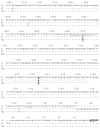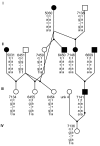Cytidine monophospho-N-acetylneuraminic acid hydroxylase (CMAH) mutations associated with the domestic cat AB blood group
- PMID: 17553163
- PMCID: PMC1913925
- DOI: 10.1186/1471-2156-8-27
Cytidine monophospho-N-acetylneuraminic acid hydroxylase (CMAH) mutations associated with the domestic cat AB blood group
Abstract
Background: The cat has one common blood group with two major serotypes, blood type A that is dominant to type B. A rare type AB may also be allelic and is suspected to be recessive to A and dominant to B. Cat blood type antigens are defined, N-glycolylneuraminic acid (NeuGc) is associated with type A and N-acetylneuraminic acid (NeuAc) with type B. The enzyme cytidine monophospho-N-acetylneuraminic acid hydroxylase (CMAH) determines the sugar bound to the red cell by converting NeuAc to NeuGc. Thus, mutations in CMAH may cause the A and B blood types.
Results: Genomic sequence of CMAH from eight cats and the cDNA of four cats representing all blood types were analyzed to identify causative mutations. DNA variants consistent with the blood types were genotyped in over 200 cats. Five SNPs and an indel formed haplotypes that were consistent with each blood type.
Conclusion: Mutations in type B cats likely disrupt the gene function of CMAH, leading to a predominance of NeuAc. Type AB concordant variants were not identified, however, cDNA species suggest an alternative allele that activates a downstream start site, leading to a CMAH protein that would be altered at the 5' region. The cat AB blood group system is proposed to be designated by three alleles, A > aab > b. The A and b CMAH alleles described herein can distinguish type A and type B cats without blood sample collections. CMAH represents the first blood group gene identified outside of non-human primates and humans.
Figures




References
-
- Bell K. The blood groups of domestic mammals. In: Agar, N.S., Board PG, editor. Red blood cells of domestic mammals. Elsevier Science Publishers; 1983. pp. 133–164.
-
- Eyquem A, Podliachouk L, Millot P. Blood groups in chimpanzees, horses, sheep, pigs, and other mammals. Ann N Y Acad Sci. 1962;97:320–328. - PubMed
-
- Holmes R. Blood groups in cats. J Physiol. 1950;111:61p. - PubMed
Publication types
MeSH terms
Substances
Grants and funding
LinkOut - more resources
Full Text Sources
Other Literature Sources
Miscellaneous

